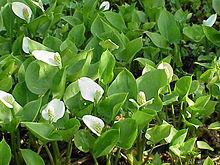Calla
| Calla | |
|---|---|
 |
|
| Scientific classification | |
| Kingdom: | Plantae |
| (unranked): | Angiosperms |
| (unranked): | Monocots |
| Order: | Alismatales |
| Family: | Araceae |
| Subfamily: | Calloideae |
| Genus: |
Calla L. |
| Species: | C. palustris |
| Binomial name | |
|
Calla palustris L. |
|
| Synonyms | |
|
|
Calla (bog arum, marsh calla, wild calla, and water-arum) is a genus of flowering plant in the family Araceae, containing the single species Calla palustris. It is native to cool temperate regions of the Northern Hemisphere, in central, eastern and northern Europe (France and Norway eastward), northern Asia and northern North America (Alaska, Canada, and northeastern contiguous United States).
It is a rhizomatous herbaceous perennial plant growing in bogs and ponds. The leaves are rounded to heart-shaped, 6–12 centimetres (2.4–4.7 in) long on a 10–20 centimetres (3.9–7.9 in) petiole, and 4–12 centimetres (1.6–4.7 in) broad. The greenish-yellow inflorescence is produced on a spadix about 4–6 centimetres (1.6–2.4 in) long, enclosed in a white spathe. The fruit is a cluster of red berries, each berry containing several seeds.
The plant is very poisonous when fresh due to its high oxalic acid content, but the rhizome (like that of Caladium, Colocasia, and Arum) is edible after drying, grinding, leaching and boiling.
...
Wikipedia

